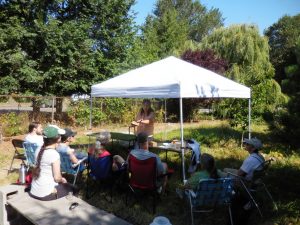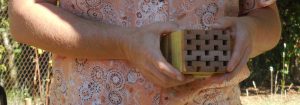In Praise of the Power of Pollinators
August 5, 2018
Gardening is hard work. It is rewarding, but the task is never over. That’s why we should always remember to give thanks to all the help we get at the orchard. Our wonderful volunteers help keep us going. But our hardest workers are some of our smallest. Without our pollinat ors, we wouldn’t be able to enjoy the bounty from our gardens. We rely on plants to power us, and our plants rely on them. They help keep our flowers, fruits, and vegetables strong.
ors, we wouldn’t be able to enjoy the bounty from our gardens. We rely on plants to power us, and our plants rely on them. They help keep our flowers, fruits, and vegetables strong.
Christine Ranegger came out to the orchard on July 21st to teach us about our six-legged volunteers. Christine is a neighborhood captain with the Puget Sound Beekeepers Association, and her expertise and passion for the bees is clear. I and the other lucky attendees learned a lot.
Sat, Sep 1, 10-noon, Work Party
Sun Sep 9, 10-11, Intro to Qi Gong
Sun, Sep 16, 2-4, Work Party
We learned about three different types of bees from our capable instructor. One of the most surprising facts I took away was that bumblebees and honey bees were two entirely different species! The honey bee is the bee most of us think of. Large nests, bee dances, and a painful stinger left in your skin are all hallmarks of the honey bee. Honey bees also have a further range than bumblebees, sometimes traveling two miles away from the hive in search of nectar. While bumblebees create nests and create complex social structures, they don’t have some of the same interesting behaviors and dynamics as honey bees. When a new honey bee queen is born, the old queen peacefully leaves the hive with a set of worker bees. If you ever see a swarm of bees, don’t hesitate to contact your local bee-keeping association or fire department! The bees might find a home with a local beekeeper, instead of in the siding of a home.
We also learned about mason bees. These bees prefer solitude, and typically range only a couple of hundred feet from their home base. They like to nest i n blocks with tubular holes in them. The females are usually placed near the back of the hole, while the male cocoons are placed near the front. This strategy allows the males to hatch first and protects the valuable, pollinating female cocoons from hungry woodpeckers!
n blocks with tubular holes in them. The females are usually placed near the back of the hole, while the male cocoons are placed near the front. This strategy allows the males to hatch first and protects the valuable, pollinating female cocoons from hungry woodpeckers!
The weather was perfect, and I left inspired to seek out my apian friends the next time I walked past a lavender bush. It didn’t hurt that I was able to walk away with a jar of Christine’s delicious honey!
Max

There are more types of bees. Leaf cutter bees also pollinate (and leave nice round pieces cut out of your leaves). I’m sure there are others, too.
Mason bees don’t sting, but also are early spring bees and are gone by June, leaving behind cocoons in the tubes that will overwinter and hatch out next spring.
Crown Bees owned by Dave Hunter in Woodinville is a good local source of mason bee cocoons, mason bee houses etc. I have been participating in their program that provides free bee houses and bee cocoons in exchange for me giving them the cocoons in June. Fine – I just want them to pollinate my fruit trees. Dave Hunter can have my extras. He’s working on having enough cocoons to pollinate the almond trees in California. It takes a lot of back yards to get there! Since mason bees don’t fly far, Dave Hunter has recruited a bunch of people to grow mason bees in their back yards and give him the resulting cocoons. I don’t know if he’s adding new people to that group, but you could ask.
You can buy blocks with holes in, for mason bees to use as nests, but there are several pests and predators of mason bees, so you may find you don’t get any bees after a year or two. The joy of Dave Hunter’s program is that he provides clean bee blocks and clean cocoons each early spring. There’s a wasp that lives in the egg and eats it out from the inside, and another that eats the pollen left by the mason bee for its egg to live and grow on. Probably others, too. As time goes on, if you don’t clean out the holes (easier if it’s boards with grooves that come apart for cleaning and not drilled holes) the dirty holes have the predators in them and your lovely bees don’t stand a chance.
Bumble bees as the above post says are more solitary than honey bees and are also important for pollination. Both honey bees and bumble bees are active in the summer. Not mason bees, they are gone until next spring.
I have not done anything to encourage leaf cutter bees but I have a patch of leaves with nice round pieces cut out, so I know I have them, at least this year
Well written, Max!
Sorry I was out of town on July 21st! I would have been there.
Joan
I thought I’d read a paragraph or two about native bees recently. Scarabs is a group of insect enthusiasts. They put out a newsletter, and usually have a meeting with a speaker each month. Rod Crawford, who works at the Burke Museum, is the editor and his address is Burke Museum, U of W, Box 353010, Seattle 98195. Anyway in May they had a talk at their meeting about ‘The Real Lives of America’s Bees, Masons Miners and Thieves’, by Paige Embry. She wrote a book on our native bees. I did not make the meeting, but the blurb says that honeybees are not native bees, they are European imports. And there are 4000 species of native bees in America. 4000!! Who knew? The Seattle Public Library has her book. Sounds like interesting reading!